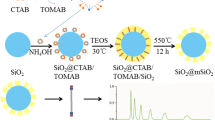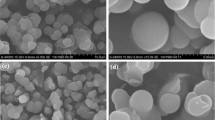Abstract
Mercaptopropyl functionalized polymethylsilsesquioxane microspheres have been prepared by a two-step acid/base catalyzed hydrolysis and co-condensation of methyltrimethoxysilane (MTMS) and mercaptopropyltrimethoxysilane (MpTMS) precursors. The mercaptopropyl loading of the microspheres is controlled by regulating the ratio of MpTMS to MTMS in the reaction feedstock. A pronounced decrease in surface area, pore volume, and pore size with increasing mercaptopropyl loading was observed and a transition in pore structure from mesopores to micropores/nearly nonporous occurred at mole fractions of mercaptopropyl groups greater than 0.23. The resulting particles exhibited low silanol/thiol activity as both the concentrations and dissociation constants of the acidic groups were considerably lower than those reported for inorganic silica-based packings. Chromatographic evaluation using a test mixture containing uracil, toluene, ethylbenzene, quinizarin, and amitriptyline revealed that the new materials possess typical reverse phase chromatographic properties with moderate methylene selectivity and intrinsic inertness to bases. Taken together, the mercaptopropyl functionalized microspheres are a promising alternative to base-deactivated silica-based packings for the separation of the basic compounds which constitute a large proportion of pharmaceuticals.
Graphical abstract








Similar content being viewed by others
References
Sanchez C, Belleville P, Popall M, Nicole L (1995) Applications of advanced hybrid organic–inorganic nanomaterials: from laboratory to market. Chem Soc Rev 40:696–753
Hoffmann F, Froba M (2011) Vitalising porous inorganic silica networks with organic functions—PMOs and related hybrid materials. Chem Soc Rev 40:608–620
Kanamori K, Nakanishi K (2011) Controlled pore formation in organotrialkoxysilane-derived hybrids: from aerogels to hierarchically porous monoliths. Chem Soc Rev 40:754–770
Kanamori K, Yonezawa H, Nakanishi K, Hirao K, Jinnai H (2004) Structural formation of hybrid siloxane-based polymer monolith in confined spaces. J Sep Sci 27:874–886
Dong HJ, Brook MA, Brennan JD (2005) A new route to monolithic methylsilsesquioxanes: gelation behavior of methyltrimethoxysilane and morphology of resulting methylsilsesquioxanes under one-step and two-step processing. Chem Mater 17:2807–2816
Dong H, Brennan JD (2006) Controlling the morphology of methylsilsesquioxane monoliths using a two-step processing method. Chem Mater 18:541–546
Popp M, Sulyok M, Rosenberg E (2007) Chromatographic characterisation of a novel type of monolithic methylsilsesquioxane-based HPLC column. J Sep Sci 30:2888–2899
Laschober S, Rosenberg E (2008) Chromatographic characterisation of monolithic capillary columns for liquid chromatography based on methyltrimethoxysilane as sole precursor. J Chromatogr A 1191:282–291
Kim DJ, Chung JS, Ahn WS, Kang GW, Cheong WJ (2004) Morphology control of organic–inorganic hybrid mesoporous silica by microwave heating. Chem Lett 33:422–423
Rebbin V, Schmidt R, Froba M (2006) Spherical particles of phenylene-bridged periodic mesoporous organosilica for high-performance liquid chromatography. Angew Chem Int Ed 45:5210–5214
Zhu G, Yang Q, Jiang D, Yang J, Zhang L, Li Y, Li C (2006) Synthesis of bifunctionalized mesoporous organosilica spheres for high-performance liquid chromatography. J Chromatogr A 1103:257–264
Zhang Y, Jin Y, Dai P, Hu H, Yu D, Ke Y, Liang X (2009) Phenylene-bridged hybrid silica spheres for high performance liquid chromatography. Anal Methods 1:123–127
Wan QH, Huo ZX, Chen L (2016) Monodispersed porous polysilsesquioxane microspheres and their preparation. In: Chinese patent CN106084228A. http://www.google.com/patents/CN106084228A. Published date 09 Nov 2016
Norma M, Scully NM, O’Sullivan GP, Healy LO, Glennon JD, Dietrich B, Albert K (2007) Preparation of a mercaptopropyl bonded silica intermediate in supercritical carbon dioxide: synthesis, characterisation and chromatography of a quinine based chiral stationary phase. J Chromatogr A 1156:68–74
Dabre R, Schwämmle A, Lämmerhofer M, Lindner W (2009) Statistical optimization of the silylation reaction of a mercaptosilane with silanol groups on the surface of silica gel. J Chromatogr A 1216:3473–3479
Hoyle CE, Bowman CN (2010) Thiol-ene click chemistry. Angew Chem Int Ed 49:1540–1573
Ruderisch A, Iwanek W, Pfeiffer J, Fischer G, Albert K, Schurig V (2005) Synthesis and characterization of a novel resorcinarene-based stationary phase bearing polar headgroups for use in reversed-phase high-performance liquid chromatography. J Chromatogr A 1095:40–49
Shen A, Guo Z, Cai X, Xue X, Liang X (2012) Preparation and chromatographic evaluation of a cysteine-bonded zwitterionic hydrophilic interaction liquid chromatography stationary phase. J Chromatogr A 1228:175–182
Lämmerhofer M, Nogueira R, Lindner W (2011) Multi-modal applicability of a reversed-phase/weak-anion exchange material in reversed-phase, anion-exchange, ion-exclusion, hydrophilic interaction and hydrophobic interaction chromatography modes. Anal Bioanal Chem 400:2517–2530
Horak J, Lindner W (2008) Contribution of sulfonyl–aromatic and sulfonic acid–aromatic interactions in novel sulfonyl/sulfonic acid-embedded reversed phase materials. J Chromatogr A 1191:141–156
Mendez A, Bosch E, Roses M, Neue UD (2003) Comparison of acidity of residual silanol groups in several liquid chromatography columns. J Chromatogr A 986:33–44
Sander LC, Wise SA (2003) A new standard reference material for column evaluation in reversed-phase liquid chromatography. J Sep Sci 26:283–294
Miller CR, Vogel R, Surawski PPT, Jack KS, Corrie SR, Trau M (2005) Functionalized organosilica microspheres via a novel emulsion-based route. Langmuir 21:9733–9749
Knox JH (2002) Band dispersion in chromatography—a universal expression for the contribution from the mobile zone. J Chromatogr A 960:7–18
Hohenesche CF, Ehwald V, Unger KK (2004) Development of standard operation procedures for the manufacture of n-octadecyl bonded silicas as packing material in certified reference columns for reversed-phase liquid chromatography. J Chromatogr A 1025:177–187
Unger K, Scharf B (1976) Controlled porosity silica supports from hydrolytic polycondensation reaction of poly(ethoxysiloxane). J Colloid Interface Sci 55:377–380
Wyndham KD, O’Gara JE, Walter TH, Glose KH, Lawrence NL, Alden BA, Izzo GS, Hudalla CJ, Iraneta PC (2003) Characterization and evaluation of C18 HPLC stationary phases based on ethyl-bridged hybrid organic/inorganic particles. Anal Chem 75:6781–6788
Gregg SJ, Sing KSW (1982) Adsorption, surface area and porosity. Academic Press, New York
Thommes M (2007) Textural characterization of zeolites and ordered mesoporous materials by physical adsorption. Stud Surf Sci Catal 168:495–523
Matsoukas T, Guilari E (1988) Dynamics of growth of silica particles from ammonia-catalyzed hydrolysis of tetra-ethyl-orthosilicate. J Colloid Interface Sci 124:252–261
Carcouet CCMC, van de Put MWP, Mezari B, Magusin PCMM, Laven J, Bomans PHH, Fridrich H, Esteves ACC, Sommerdijk NAJM, van Benthem RATM, de With AC (2014) Nucleation and growth of monodisperse silica nanoparticles. Nano Lett 14:1433–1438
Li S, Wan Q, Qin Z, Fu Y, Gu Y (2014) Understanding Stober silica’s pore characteristics measured by gas adsorption. Langmuir 31:824–832
Zhou X, Wan QH (2015) Separation and identification of oligomeric phenylethoxysiloxanols by liquid chromatography–electrospray ionization mass spectrometry. J Sep Sci 38:1484–1490
Jiang Y, Wan QH (2015) Separation and identification of oligomeric ethyl silicates by liquid chromatography with electrospray ionization mass spectrometry. J Chromatogr A 1394:95–102
Jia G, Wan QH (2015) Separation and identification of oligomeric vinylmethoxysiloxanes by gradient elution chromatography coupled with electrospray ionization mass spectrometry. J Chromatogr A 1395:129–135
Zub YL, Stolyarchuk NV, Melnyk IV, Chuiko AA, Dabrowski A, Barczak M (2005) New adsorbents based on bridged polysilsesquioxanes containing 3-mercaptopropyl functional groups. Mendeleev Commun 15:168–170
Nawrocki J (1997) The silanol group and its role in liquid chromatography. J Chromatogr A 779:29–71
Duchateau R, Dijkstra TW, van Santen RA, Yap GPA (2004) Silsesquioxane models for silica surface silanol sites with adjacent siloxide functionalites and olefin polymerization catalysts thereof. Chem Eur J 10:3979–3990
Chivers PT, Prehoda KE, Volkman BF, Kim BM, Markley JL, Raines RT (1997) Microscopic pKa values of Escherichia coli thioredoxin. Biochemistry 36:14985–14991
Poole CF (2015) An interphase model for retention in liquid chromatography. J Planar Chromatogr 28:98–105
Author information
Authors and Affiliations
Corresponding author
Ethics declarations
Conflict of interest
Authors declare no conflict of interest.
Ethical approval
This article does not contain any studies with human participants or animals performed by any of the authors.
Rights and permissions
About this article
Cite this article
Li, J., Huo, Z., Chen, L. et al. Mercaptopropyl Functionalized Polymethylsilsesquioxane Microspheres Prepared by Co-Condensation Method as Organosilica-Based Chromatographic Packings. Chromatographia 80, 1287–1297 (2017). https://doi.org/10.1007/s10337-017-3349-4
Received:
Revised:
Accepted:
Published:
Issue Date:
DOI: https://doi.org/10.1007/s10337-017-3349-4




